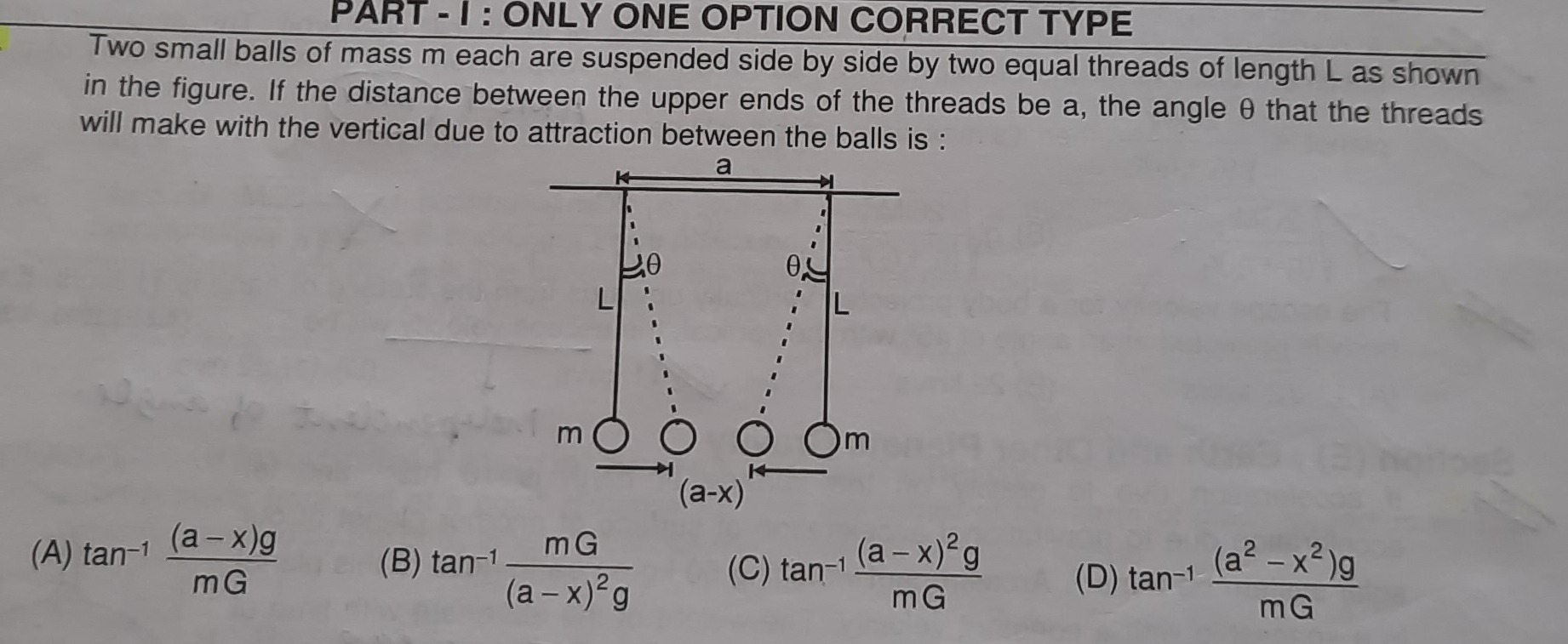Question
Question: Two small balls of mass m each are suspended side by side by two equal threads of length L as shown ...
Two small balls of mass m each are suspended side by side by two equal threads of length L as shown in the figure. If the distance between the upper ends of the threads be a, the angle θ that the threads will make with the vertical due to attraction between the balls is :

tan−1mG(a−x)g
tan−1(a−x)2gmG
tan−1mG(a−x)2g
tan−1mG(a2−x2)g
B
Solution
The problem describes two small balls of mass m suspended by threads of length L. Due to mutual gravitational attraction, the threads make an angle θ with the vertical. The distance between the upper ends of the threads is a, and the distance between the centers of the balls in the equilibrium position is (a-x).
Let's consider the forces acting on one of the balls:
- Weight (gravitational force):
W = mg, acting vertically downwards. - Tension in the thread:
T, acting along the thread. - Gravitational force of attraction from the other ball:
F_G, acting horizontally towards the other ball.
The ball is in equilibrium, so the net force on it is zero. We resolve the tension T into its horizontal and vertical components.
- Vertical component:
T cos θ(upwards) - Horizontal component:
T sin θ(towards the other ball, away from the vertical line of suspension)
Applying the conditions for equilibrium:
1. Vertical Equilibrium:
The upward vertical component of tension balances the downward weight:
T cos θ = mg (Equation 1)
2. Horizontal Equilibrium:
The horizontal component of tension balances the gravitational attractive force between the balls:
T sin θ = F_G (Equation 2)
Now, let's calculate the gravitational force F_G. According to Newton's Law of Universal Gravitation, the force between two masses m1 and m2 separated by a distance r is F = G * (m1 * m2) / r^2.
In this case, m1 = m, m2 = m, and the distance r between the balls is (a-x).
So, F_G = G * (m * m) / (a-x)^2 = Gm^2 / (a-x)^2
Substitute F_G into Equation 2:
T sin θ = Gm^2 / (a-x)^2 (Equation 3)
Now, divide Equation 3 by Equation 1 to eliminate T:
(T sin θ) / (T cos θ) = (Gm^2 / (a-x)^2) / (mg)
tan θ = (Gm^2 / (a-x)^2) * (1 / mg)
tan θ = Gm / ((a-x)^2 * g)
Finally, solve for θ:
θ = tan⁻¹ [Gm / ((a-x)^2 * g)]
Our derived expression matches option (B).
